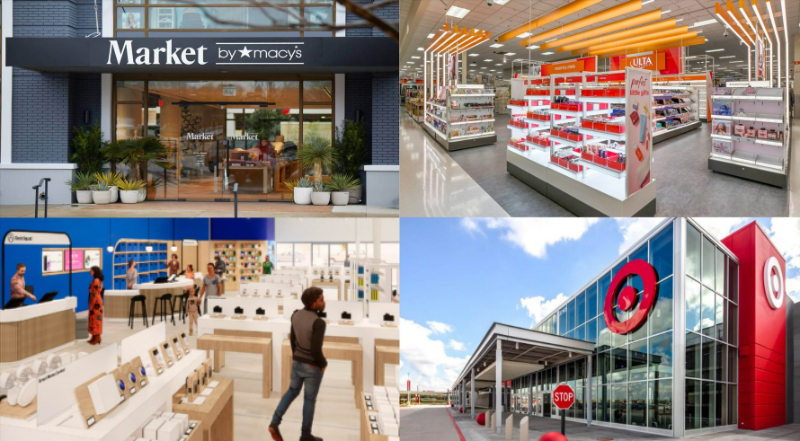
March 9, 2023 – Creativity flourished in 2022 as big retailers found new ways to grow with smaller formats and reduce existing square feet by subleasing space to other companies that benefit their businesses. The trend is likely to carry over to 2023 and beyond. According to commercial real estate and property investment firm Jones Lang LaSalle (JLL), in its “U.S. Retail Outlook Q4 2022” report, retailers will continue to explore new store formats, including mini-department stores, “shop-in-shop” formats, and even smaller digital concepts.
In Q4 2022, the average size of new leases dropped to 3,185 square feet (JLL). Macy’s department store is one example of a retailer that is moving small to grow bigger. Macy’s currently has eight small-format Market by Macy’s stores and two Bloomie’s stores. Compared to their larger-format mall stores, these shops have seen success across the board in customer approval with two and a half times higher foot traffic and significantly higher conversion rates. Macy’s is likely to continue this strategy by exiting mall spaces to open new stores in open-air shopping centers where competitors such as Kohl’s, TJX companies, Nordstrom Rack, and others have found success. According to Macy’s CEO Jeff Genette, the retailer plans to open four new Market by Macy’s locations and one new Bloomie’s store in 2023 (Retail Dive).
Similarly, Kohl’s announced plans in May 2022 to open around 100 smaller footprint stores, reducing their size from 80,000 square feet to around 35,000 to 55,000 square feet, depending on the market, over the next four years. Additionally, about 850 of their locations will offer a Sephora shop in 2023 (Chain Store Age). Many retailers have expanded their footprint with the “shop-in-shop” strategy, by placing a smaller version of their store inside stores of other larger retailers. For instance, Ulta Beauty’s partnership with Target in 2021 resulted in increased traffic, awareness, and loyalty for both brands. In 2023, Target plans to open about 20 new stores varying in size, and their goal to fuel growth and create a differentiated guest experience will be aided by opening more Ulta Beauty mini-shops, as well as mini-Apple stores that started in 2021, at Target shop-in-shop experiences (Target). The “shop-in-shop” partnership allows the featured retailer to pay much less than it would cost to rent and operate a full store location while getting immediate access to the foot traffic and consumer base of the larger retailer. On the other hand, the larger retailer mitigates operational costs by subleasing a portion of their space while broadening their own consumer base. Other retailers participating in this trend include Petco in Lowe’s and Toys R Us in Macy’s.
Further, consumer behavior has shifted since the pandemic, and stores have accelerated their adjustment to the demand for online shopping ease with instore pickup options, self-checkout options, and the overall desire for a frictionless experience. One retailer that is breaking the mold to follow these changes is Best Buy, who in July 2020 introduced a small-format digital QR code store that only carries the best-in-category products and uses QR codes to order other products online from inside the store. The QR codes are also used to scan the products that are available in-store as customers are browsing, and the scanned products are then placed at a pick-up counter for the customer to take on their way out for a more efficient shopping experience. The store also offers 24-hour outdoor pickup lockers for products that are not stocked in the store but are ordered from Best Buy online (Best Buy) The store is only 5,000 square feet in comparison to Best Buy’s typical store size of anywhere from 35,000 to 60,000 square feet.
Internet sales have pushed retailers to adjust their store sizes and formats to remain viable in their current markets. However, to continue to grow their business, many companies are reducing their size and overall cost structure so they can expand into smaller markets. For example, Ulta Beauty, Michael’s, Kohl’s, and Ross Stores have smaller format store models depending on the market they are entering, whereas in the past these retailers would typically open the same size in every market. These smaller-format stores are filling vacancies and creating new developments in small cities throughout the U.S., while also providing much needed new store and revenue growth for their companies.
While there are many retailers that have embraced smaller footprints, some retailers have not reduced their size at all and have actually increased their size in several markets. Target is one example of a company that is experimenting with both smaller and larger store formats. In 2022, Target opened its first larger-format store at 150,000 square feet, which is about 20% larger than the current chain average (ChainStore Age). The new store is able to accommodate online orders and same-day services through a backroom fulfilment area that is five times bigger than other stores. Further, the Target Drive Up service allows customers to place their order online and pick it up or drop off a return, all from the comfort of their car. Target expects nearly all store locations will offer Drive Up Returns by the end of the 2023 summer season (Target).
As more retailers explore options to lease smaller spaces, sublease to other retailers for a “shop-in-shop” experience, experiment with more digital-friendly formats, and push the boundaries of where they will locate, it will be interesting to see which direction retailers go in the future to grow their businesses.